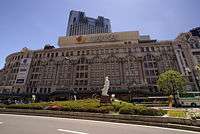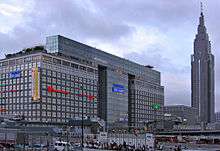Takashimaya
|
| |
| Public KK | |
| Traded as | TYO: 8233 |
| Industry | Retailing |
| Founded | Kyoto, January 10, 1831 |
| Founder | Shinshichi Iida |
| Headquarters | Chuo-ku, Osaka, Japan |
Areas served |
Japan Singapore China Taiwan Thailand Vietnam |
Key people | Shigeru Kimoto, President |
| Services |
Department stores E-commerce |
| Revenue | JPY 912.5 bn (2014) |
| JPY 32.0 bn (2014) | |
| JPY 22.6 bn (2014) | |
| Total assets | JPY 979.6 bn (2014) |
| Total equity | JPY 408.5 bn (2014) |
Number of employees | 14,662 (2015) |
| Website | http://www.takashimaya.co.jp/ |
|
Footnotes / references Financial data per "Fact Book". Takashimaya. Retrieved 9 June 2015. | |



Takashimaya Co., Ltd. (株式会社髙島屋 Kabushiki-gaisha Takashimaya) is a Japanese company that operates a department store chain carrying a wide array of products, ranging from wedding dresses and other apparel to electronics and flatware.
Takashimaya was listed at #1197 on the Forbes Global 2000 list for 2006.[1]
Takashimaya is a member of the Mitsubishi UFJ Financial Group (MUFJ) keiretsu.
History
The first Takashimaya store was opened in Kyoto in 1831 as a sole proprietorship owned by Shinshichi Iida, a merchant from present-day Fukui Prefecture.[2] The original store in Kyoto was only 3.6 square meters in area and specialized in selling gofuku (formal kimono). A second Kyoto store opened in 1893, followed by a Tokyo store in 1897 and an Osaka store in 1898.[3] Takashimaya was incorporated as a gomei kaisha (unlimited liability company) in 1909 and converted to a kabushiki kaisha (stock company) in 1919.[4]
Takashimaya began an export business in 1876, following the Meiji Restoration, and established an in-house trading unit in 1887.[2] By 1903 Takashimaya had offices in Paris and London and an export office in Yokohama.[3] The trading unit was spun off as a new stock company, Takashimaya-Iida (高島屋飯田株式会社), in 1913.[2] Takashimaya-Iida later merged with the trading company Marubeni.[5]
The chain saw a major expansion in the early 1930s. In 1931 it opened a "10, 20 and 50 sen store" in Osaka, a predecessor of today's 100 yen store. Its flagship store in Namba, Osaka opened in 1932, and a second flagship store in Ginza, Tokyo opened in 1933. The Tokyo and Osaka stores were damaged by the firebombings of Tokyo and Osaka in 1945 but were not destroyed, and served as centers for logistics during the occupation of Japan.[4] Due to postwar regulations on the size of new stores, many Takashimaya locations opened from the 1950s onward, including its Yokohama and Yonago stores, were set up as separate companies.[3]
In 1958, Takashimaya opened a store in New York City which eventually occupied 37,000 square feet of floor space at 693 Fifth Avenue. The New York store closed in 2010 as Takashimaya chose to refocus on Asian markets amid struggling sales.[6]
In 1969, Takashimaya opened Japan's first American-style suburban shopping center near Futako-Tamagawa Station, to the southwest of Tokyo.[3]
The Japanese department store industry went through a wave of consolidation during a revenue slump in the 2000s, with Isetan Mitsukoshi Holdings (parent of Mitsukoshi and Isetan) becoming the largest player in the industry, followed by J. Front Retailing (parent of Daimaru Matsuzakaya Department Stores). In 2008, Takashimaya announced plans to merge with H2O Retailing, the parent of the Osaka-based Hanshin Department Store and Hankyu Department Store chains, which would have formed the largest department store operator in Japan. Takashimaya and H2O entered into a cross-shareholding relationship prior to the merger, with each acquiring 10% of the other's stock, but announced the cancellation of their merger in 2010.[7]
Stores
Directly owned
- Kansai
- Osaka - Nankai Building 1-5, Namba Gochome, Chuo-ku, Osaka, the north side of Nankai Railway Namba Station
- Sakai - Nankai Sakaihigashi Building, 59, Mikunigaoka-Miyukidori, Sakai-ku, Sakai, near Sakaihigashi Station on the Nankai Railway Koya Line
- Wakayama - the station building of Wakayamashi Station on the Nankai Railway Nankai Line, 306, Higashikuramaecho, Wakayama - scheduled to be closed in August 2014.
- Semboku - Panjo, 1-3-1, Chayamadai, Minami-ku, Sakai, near Semboku Rapid Railway Izumi-Chuo Station
- Kyoto - 52, Shincho, Shijo-dori Kawaramachi Nishi-hairu, Shimogyo-ku, Kyoto (Kawaramachi Station on the Hankyu Railway Kyoto Line is connected underground.)
- Rakusai - Rakuseine, 5-5, Oharano Higashi-Sakaidanicho Nichome, Nishikyo-ku, Kyoto, near Rakusai Bus Terminal (Kyoto Municipal Bus, Keihan Kyoto Kotsu, Hankyu Bus)
- Kanto
- Nihombashi - 4-1, Nihombashi 2-chome, Chuo, Tokyo, the historical structure selected by Tokyo Metropolitan Government, near Nihombashi Station (Tokyo Metro, Toei Subway)
- Shinjuku - Shinjuku Takashimaya Times Square, 24-2, Sendagaya Gochome, Shibuya, connected with the South Gate of JR East Shinjuku Station and with Shinjuku-sanchome Station on the Tokyo Metro Fukutoshin Line.
- Tamagawa - the core tenant of Tamagawa Takashimaya Shopping Center in 17-1, Tamagawa Sanchome, Setagaya, near Tokyu Futako-Tamagawa Station
- Tachikawa - Faret Tachikawa, 39-3, Akebonocho Nichome, Tachikawa, near Tama Monorail Tachikawa-Kita Station
- Yokohama - Takashimaya Building, Sotetsu Joinus in the same location as Yokohama Station on the Sotetsu Main Line, 6-31, Minami-saiwai Itchome, Nishi-ku, Yokohama
- Konandai - Konandai Birds, 1-3, Konandai Sanchome, Konan-ku, Yokohama, near Konandai Station on the JR East Negishi Line
- Takashimaya Food Maison Shin-Yokohama - Cubic Plaza Shin-Yokohama, Kohoku-ku, Yokohama, near Shin-Yokohama Station on the JR Central Tokaido Shinkansen, the JR East Yokohama Line and the Yokohama Subway Blue Line
- Omiya - 32, Daimoncho Itchome, Omiya-ku, Saitama the east side of Omiya Station (JR East, Saitama New Urban Transit, Tobu Railway)
- Kashiwa - Takashimaya Station Mall, 3-16, Suehirocho, Kashiwa, Chiba the West side of Kashiwa Station (JR East, Tobu Railway)
- Takashimaya Food Maison Otakanomori - Nagareyama-Otakanomori Shopping Center, in Nagareyama, near Nagareyama-ōtakanomori Station (Tsukuba Express, Tobu Railway Noda Line)
Subsidiaries
- Takasaki Takashimaya - 45, Asahicho, Takasaki, the west of Takasaki Station (JR East, Joshin Railway)
- Gifu Takashimaya - 25, Hinodecho Nichome (Yanagase), Gifu
- Okayama Takashimaya - 6-40, Hommachi, Kita-ku, Okayama, near JR West Okayama Station
- Yonago Takashimaya - 30, Kakubancho Itchome, Yonago
Joint venture
- JR Nagoya Takashimaya - JR Central Towers, 1-4, Meieki 1-chome, Nakamura-ku, Nagoya, in the east side of JR Central Nagoya Station, joint venture with JR Central.
- Iyotetsu Takashimaya - 4, Minatomachi Itchome, Matsuyama, the same location as Iyotetsu Matsuyamashi Station, joint venture with Iyo Railway Co., Ltd.
- Shanghai Takashimaya - 1438, Hongqiao Road, Changning District, Shanghai, China
- Dayeh Takashimaya - Taipei
- Takashimaya Singapore - 391 Orchard Road, Orchard Planning Area, Singapore, joint venture between Ngee Ann Kongsi and Takashimaya agreed upon in 1988, store located inside Ngee Ann City.
- Takashimaya Vietnam - 65 Le Loi Boulevard, Saigon Centre Planning Area, Ho Chi Minh, joint venture, store located inside Saigon Centre.
- Takashimaya Thailand - Bangkok, Thailand, joint venture between Siam Piwat and Charoen Pokphand, store located inside ICONSIAM shopping mall.
See also
References
- ↑ The World's Biggest Public Companies - Forbes.com
- 1 2 3 "Takashimaya Archives 1831-1908". Takashimaya. Retrieved 9 June 2015.
- 1 2 3 4 "Takashimaya Company, Limited History". International Directory of Company Histories, Vol. 47. St. James Press, 2002. Retrieved 9 June 2015.
- 1 2 "Takashimaya Archives 1909-1945". Takashimaya. Retrieved 9 June 2015.
- ↑ "Marubeni Corporation History". International Directory of Company Histories, Vol. 24. St. James Press, 1999. Retrieved 9 June 2015.
- ↑ Pasquarelli, Adrianne (25 March 2010). "Upscale department store Takashimaya closing". Crain's. Retrieved 9 June 2015.
- ↑ Uranaka, Taiga (25 March 2010). "Japan dept stores Takashimaya and H2O cancel merger". Reuters. Retrieved 9 June 2015.
External links
| Wikimedia Commons has media related to Takashimaya. |
- (Japanese) Takashimaya
- (English) (Japanese) Takashimaya Singapore
- (English) Takashimaya Vietnam